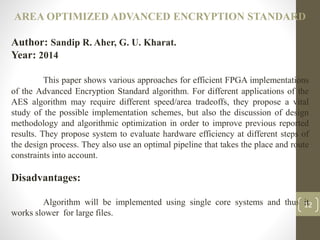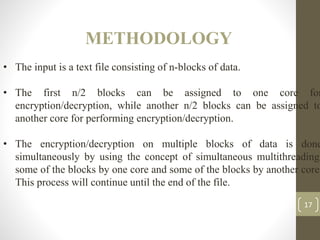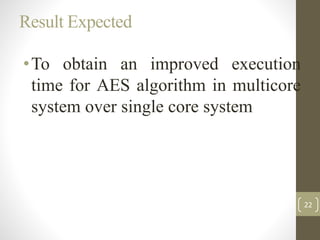First phase slide presentation on "ANALYZING THE EFFECTIVENESS OF THE ADVANCED ENCRYPTION STANDARD ALGORITHM ON MULTICORE PROCESSOR "
- 1. ANALYZING THE EFFECTIVENESS OF THE ADVANCED ENCRYPTION STANDARD ALGORITHM ON MULTICORE PROCESSOR Presented By Chethan B M 4BB13CS011 Nikhil Jain C S 4BB13CS021 Sharath M S 4BB13CS029 Under the guidance of Mrs. Kavitha C.R. Associate Professor & HOD DEPARTMENT OF COMPUTER SCIENCE AND ENGINEERING 1
- 2. CONTENTS • Aim • Scope • Objectives • Problem definition • Literature survey • Existing system • Drawbacks of Existing systems • Advantages of proposed system • Methodology • Hardware and software requirements • References • Result expected • Gantt chart 2
- 3. AIM To implement and improve the performance of Advanced Encryption Standard algorithm by using multicore systems and OpenMP API extracting as much parallelism as possible from the algorithm in parallel implementation approach. 3
- 4. SCOPE • The requirement of information security on a network has become highly challenging. • Cryptography is a method to provide information confidentiality, authenticity and integrity. • The cryptography overcomes several challenges such as execution time, memory requirement, and computation power. However, one cannot get desired outcomes by using sequential computation. 4
- 5. OBJECTIVES • To facilitate encryption and decryption of large data. • To reduce execution time by using multicore system. • To compare the execution time of single core and multicore systems. 5
- 6. PROBLEM DEFINITION • Secure transmission of information from one place to another. • The sensitive information must be unreadable to all others except the receiver. • Performance limitations of AES algorithm such as memory requirement and execution time. • Secure way of transfering the sensitive information. 6
- 7. LITERATURE SURVEY PERFORMANCE IMPROVEMENT OF ADVANCED ENCRYPTION ALGORITHM USING PARALLEL COMPUTATION Author: M. Nagendra, M. Chandra Sekhar. Year: 2014 In this paper, mainly divide-and-conquer strategy is used in parallel computation to solve the algorithms in parallel by partitioning and allocating, number of given subtask to available processing units. Disadvantages: Divide and conquer strategy works slow for large data files and recursion is slow. Sometimes once the problem is broken down into some sub problems, the same sub problem can occur many times. 7
- 8. AN IMPLEMENTATION OF AESALGORITHM ON MULTICORE PROCESSORS FOR HIGH THROUGHPUT Author: Supachai Thongsuk, Prabhas. Year: 2014 AES algorithm is a block encryption algorithm established by the U.S. National Institute of Standards and Technology (NIST) in 2001. It has been adopted by many data security systems and now used worldwide. Most of AES implementations are for single-core processors. To achieve high performance for large data, this work proposed an AES algorithm for multi-core processors. Using parallelism inherent in large data, all cores are working concurrently to speed up the task. Disadvantages: In this paper, Open MP (Open multiprocessing) is not used. Open MP is one of the application programming interface which is supported by multicore architectures to provide multithreaded shared memory parallelism. So by using multicore architectures we can parallelize the execution of AES algorithm among different cores to reduce the execution time of the algorithm. 8
- 9. DESIGN OFAN EFFICIENT ARCHITECTURE FOR ADVANCED ENCRYPTION STANDARD ALGORITHM USING SYSTOLIC STRUCTURES Author: Suresh Sharma, T S B Sudarshan. Year: 2005 This Paper presents a systolic architecture for Advanced Encryption standard (AES). Use of systolic architecture has improved the hardware complexity and the rate of encryption/decryption. Similarities of encryption and decryption are used to provide a high performance using an efficient architecture. The encryption or decryption rate increases due to the use of pipelined systolic architecture. Disadvantages: Here only one core is used irrespective of the size of the file which has to be encrypted or decrypted. This method will work slowly if the data file is big in size. It may work well for data files which are small but it is sure that it takes much longer time to encrypt and decrypt the data for bigger files 9
- 10. DESIGN AND IMPLEMENTATION A DIFFERENT ARCHITECTURES OF MIXCOLUMN IN FPGA Author: Sliman Arrag, Abdellatif Hamdoun, Abderrahim Tragha and Salah eddine Khamlich Year: 2014 This paper details Implementation of the Encryption algorithm AES under VHDL language In FPGA by using different architecture of mixcolumn. We then review this research investigates the AES algorithm in FPGA and the Very High Speed Integrated Circuit Hardware Description language (VHDL). Altera Quartus II software is used for simulation and optimization of the synthesizable VHDL code. Disadvantages: VHDL is complicated and confusing language. Hardware that is synthesized is not always obvious. Constructs that have similar syntax have very different semantics. It is not suitable for verifying the basic objects like gates. Mixcolumn is a modular multiplication which is a complex one. 10
- 11. REORDERING ALGORITHMS FOR INCREASING LOCALITY ON MULTICORE PROCESSORS Author: Juan C. Pichel, David E. Singh and Jes´us Carretero. Year: 2014 In this paper a technique for increasing locality of sparse matrix codes on multicore platforms is presented. The technique consists on reorganizing the data guided by a locality model which introduces the concept of windows of locality. The evaluation of the reordering technique has been performed on two different leading multicore platforms: Intel Core2Duo and Intel Xeon. Disadvantages: The proposed data reordering technique has been tested on two different leading multicore processors: Intel Core2Duo and Intel Xeon only. All the codes were written in C, which makes more complex. 11
- 12. AREA OPTIMIZED ADVANCED ENCRYPTION STANDARD Author: Sandip R. Aher, G. U. Kharat. Year: 2014 This paper shows various approaches for efficient FPGA implementations of the Advanced Encryption Standard algorithm. For different applications of the AES algorithm may require different speed/area tradeoffs, they propose a vital study of the possible implementation schemes, but also the discussion of design methodology and algorithmic optimization in order to improve previous reported results. They propose system to evaluate hardware efficiency at different steps of the design process. They also use an optimal pipeline that takes the place and route constraints into account. Disadvantages: Algorithm will be implemented using single core systems and thus it works slower for large files. 12
- 13. 13 PARALLEL EXECUTION OF AES-CTR ALGORITHM USING EXTENDED BLOCK SIZE Author: Nhat-Phuong Tran, Myungho Lee, Sigwon Hong. Year: 2011 In this paper, they propose a new approach to parallelize AES-CTR algorithm by extending the size of the block which is encrypted at one time across the unit block boundaries. The proposed approach leads to significant performance improvements using a general-purpose multi-core processor and a Graphic Processing Unit (GPU) which become popular those days. Disadvantages: In this paper, GPU is used which consumes more power, so this could effect battery life and also cost of GPU is high
- 14. Existing System • The implementation of encrypting the data that is converting the plain text in to cipher text and decrypting the data is by using the single core system. • The concept of double encryption and double decryption is used. • Since twice encryption and decryption takes much time. 14
- 15. Drawbacks of Existing systems • In the existing system only one core is used irrespective of the size of the file which has to be encrypted or decrypted. • Using only one core will work slowly if the data file is big in size. It may work well for data files which are small but it is sure that it takes much longer time to encrypt and decrypt the data for bigger files. 15
- 16. ADVANTAGES OF PROPOSED SYSTEM • The concept of parallel programming by using a multi- core processor is proposed . • Proposed system shows how to efficiently and effectively implement the Advanced Encryption Algorithm by using multicore systems and OpenMP API. • The AES algorithm is implemented using multi core systems and thus it works faster even for large files. • The time taken to encrypt/decrypt the large data is reduced. • The comparision of execution time of single core system and multicore system is shown. 16
- 17. METHODOLOGY 17 • The input is a text file consisting of n-blocks of data. • The first n/2 blocks can be assigned to one core for encryption/decryption, while another n/2 blocks can be assigned to another core for performing encryption/decryption. • The encryption/decryption on multiple blocks of data is done simultaneously by using the concept of simultaneous multithreading, some of the blocks by one core and some of the blocks by another core. This process will continue until the end of the file.
- 18. 18
- 19. HARDWAREAND SOFTWARE REQUIREMENTS •1.4 GHz processor •2 GB RAM •40 GB hard disk •JDK 1.8 •Eclipse •Apache tomcat 9 •MySQL 19
- 20. 20 REFERENCES JOURNALS [1] M. Nagendra and M. Chandra Sekhar ., “Performance Improvement of Advanced Encryption Algorithm using Parallel Computation”, International Journal of Software Engineering and Its Applications. [2] Supachai Thongsuk1, Prabhas Chongstitvatana., “An implementation of AES algorithm on multicore processors for high throughput”, Department of Computer Engineering Faculty of Engineering, Chulalongkorn University Bangkok, Thailand. [3] Nhat-Phuong Tran, Myungho Lee, Sigwon Hong., “Parallel Execution of AES-CTR Algorithm Using Extended Block Size”, Dept of Computer Science and Engineering, Myong Ji University. cont…
- 21. 21 cont… [4] Suresh Sharma, T S B Sudarshan., “Design of an Efficient Architecture for Advanced Encryption Standard Algorithm Using Systolic Structures”, International Conference of High Performance Computing. [5] Sliman Arrag1, Abdellatif Hamdoun 2, Abderrahim Tragha 3 and Salah eddine Khamlich., “Design and Implementation A different Architectures of mixcolumn in FPGA”, Department of Electronics and treatment of information UNIVERSITE HASSAN II MOHAMMEDIA, Casablanca, Morocco. [6] Juan C. Pichel, David E. Singh and Jes´us Carretero., “Reordering Algorithms for Increasing Locality on Multicore Processors”, Computer Science Dpt. Universidad Carlos III de Madrid, Spain.
- 22. Result Expected •To obtain an improved execution time for AES algorithm in multicore system over single core system 22
- 23. 23 THANK YOU
- 24. QUERIES??? 24




















![20
REFERENCES
JOURNALS
[1] M. Nagendra and M. Chandra Sekhar ., “Performance
Improvement of Advanced Encryption Algorithm using Parallel
Computation”, International Journal of Software Engineering and Its
Applications.
[2] Supachai Thongsuk1, Prabhas Chongstitvatana., “An
implementation of AES algorithm on multicore processors for high
throughput”, Department of Computer Engineering Faculty of
Engineering, Chulalongkorn University Bangkok, Thailand.
[3] Nhat-Phuong Tran, Myungho Lee, Sigwon Hong., “Parallel
Execution of AES-CTR Algorithm Using Extended Block Size”, Dept
of Computer Science and Engineering, Myong Ji University.
cont…](https://image.slidesharecdn.com/abc-170422181006/85/First-phase-slide-presentation-on-ANALYZING-THE-EFFECTIVENESS-OF-THE-ADVANCED-ENCRYPTION-STANDARD-ALGORITHM-ON-MULTICORE-PROCESSOR-20-320.jpg)
![21
cont…
[4] Suresh Sharma, T S B Sudarshan., “Design of an Efficient
Architecture for Advanced Encryption Standard Algorithm Using Systolic
Structures”, International Conference of High Performance Computing.
[5] Sliman Arrag1, Abdellatif Hamdoun 2, Abderrahim Tragha 3 and
Salah eddine Khamlich., “Design and Implementation A different
Architectures of mixcolumn in FPGA”, Department of Electronics and
treatment of information UNIVERSITE HASSAN II MOHAMMEDIA,
Casablanca, Morocco.
[6] Juan C. Pichel, David E. Singh and Jes´us Carretero., “Reordering
Algorithms for Increasing Locality on Multicore Processors”, Computer
Science Dpt. Universidad Carlos III de Madrid, Spain.](https://image.slidesharecdn.com/abc-170422181006/85/First-phase-slide-presentation-on-ANALYZING-THE-EFFECTIVENESS-OF-THE-ADVANCED-ENCRYPTION-STANDARD-ALGORITHM-ON-MULTICORE-PROCESSOR-21-320.jpg)


